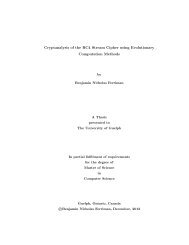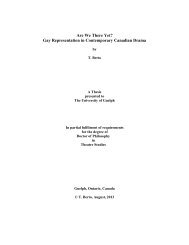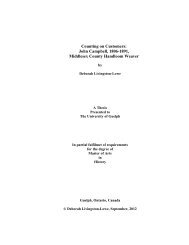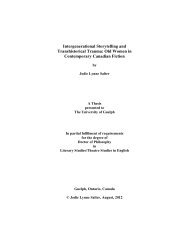THESIS - ROC CH ... - FINAL - resubmission.pdf - University of Guelph
THESIS - ROC CH ... - FINAL - resubmission.pdf - University of Guelph
THESIS - ROC CH ... - FINAL - resubmission.pdf - University of Guelph
You also want an ePaper? Increase the reach of your titles
YUMPU automatically turns print PDFs into web optimized ePapers that Google loves.
SEM images <strong>of</strong> the cryo-fractured surfaces <strong>of</strong> SPI, SNF0.25, SMF0.5, SMF1.0, and SMF<br />
2.5 are shown in Figure 6.5. The fractured plane was perpendicular to the machine direction<br />
allowing for visual indication <strong>of</strong> fiber alignment if it were to be present. However, no visible<br />
evidence <strong>of</strong> fibers was observed for any <strong>of</strong> the specimens. This was not expected as<br />
homogenous dispersion <strong>of</strong> fibers was evident via polarized light. This may suggest that cellulose<br />
and SPI have good interfacial adhesion preventing the pull out <strong>of</strong> fibers upon fracture. Poor<br />
adhesion would result in the appearance <strong>of</strong> visible fiber structures due to the fiber surfaces<br />
disengaging from the polymer matrix. The control specimen <strong>of</strong> SPI without fiber addition had<br />
relatively smooth fracture surface in comparison to all other specimens. With the addition <strong>of</strong><br />
SNF’s at 0.25%w/w SNF/SPI, irregularities could be seen to scatter across the surface. Adding<br />
SMF’s at the same loading concentration resulted in an increased surface roughness.<br />
Compared to other specimens, edges with higher variances in the depth to height ratio were<br />
observed. This jagged texture was also apparent with SMF0.5 but with a flatter appearance.<br />
The serrated valleys can be seen to widen apart with further increase in SMF addition at 1.0 and<br />
2.5% w/w SMF/SPI. In addition to the widening <strong>of</strong> the valleys, SMF1.0 and SMF 2.5 specimens<br />
have additional sunken trenches that streak across the surfaces. The most apparent <strong>of</strong> this<br />
behaviour can be seen with SMF2.5 at the highest fiber concentration with deep elongated<br />
cavities. The increasing roughness with increasing fiber addition suggests the presence <strong>of</strong> filler<br />
material. Although interfacial adhesion prevented the visual appearance <strong>of</strong> intact fibers, the<br />
rough texture may indicate that interaction is not ideal (Wang et al. 2006; Wu et al. 2009). The<br />
increased defects seen with high fiber content may negatively affect material properties.<br />
73

















